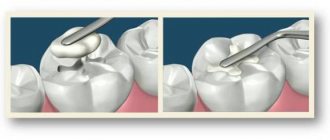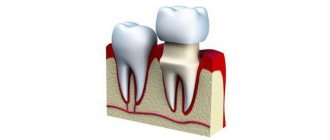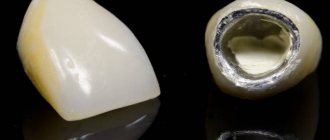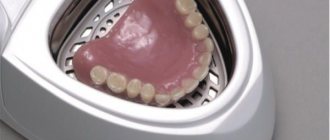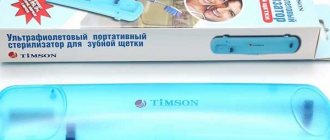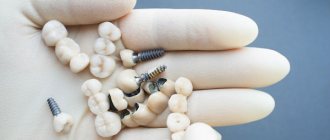4062
Coated metal crowns are popular in dental practice.
And if earlier such designs were distinguished by sparkling steel, today orthopedic dentists have abandoned unaesthetic products and prefer installing coated crowns that do not differ in appearance from the rest of the dentition.
Product characteristics
Due to their wear resistance and biocompatibility, metal alloys deserve trust as products for prosthetics.
A real breakthrough in dental practice in past years was the procedure of covering crowns with a special material under the influence of high temperatures. The formed layer on orthopedic products is called spraying.
Coated dentures have retained their main feature – a metal frame. And to create a cladding on it, the following materials are used:
- gold;
- ceramics;
- cobalt chrome;
- titanium;
- silver alloy with palladium;
- steel.
The disadvantage of most of the listed materials is the lack of naturalness, because... in accordance with the main color of the alloy, the finished product acquires the corresponding shade - gold, silver, etc.
Products with gold plating are considered the most antiseptic and durable. They have a smooth surface that prevents the proliferation of pathogens and prevents food particles from accumulating. But gold structures are very expensive, so they are inaccessible to most patients.
Models coated with titanium nitride have distinguished themselves by high aesthetic indicators. Such products are the most popular in modern dentistry.
The appearance of the crowns is as natural as possible, so they can be used to restore not only chewing teeth, but also units from the anterior section. The spraying procedure is carried out using a vacuum-plasma technique.
Metal crowns with coating mainly differ from other types of orthopedic structures in their endurance, which is characterized by the ability to withstand heavy loads during chewing processes.
The presented products are manufactured in two ways:
- stamping;
- creation of a one-piece structure based on an individual cast.
The process of applying titanium nitride to a metal frame consists of the following steps:
- disinfection of the prosthetic part;
- polishing the surface being treated;
- etching of titanium onto metal in a vacuum under high temperature.
Remarkable! Titanium nitride is not applied to the marginal part of the crown. However, after installation, this part goes under the gum, so it is invisible to others.
Let's figure out which crowns are best placed on implants and why.
Come here to understand what to do when the gums rise above the crown.
At this address https://www.vash-dentist.ru/protezirovanie/nesemnyie-p/koronki-np/naznachenie-i-stomatologicheskih-gilz.html we will consider the types of dental sockets.
Spraying teeth white
Everyone wants to have a snow-white smile. But not everyone can boast of naturally white teeth. In addition, with age, the enamel darkens due to external factors.
Most often, lovers of strong tea and coffee, as well as those who abuse smoking, suffer from yellowing of the enamel. How can you achieve a whiter smile?
About dental spraying
In dentistry, there is a method called spraying; its essence is to apply specific paint to the teeth. It firmly adheres to the surface and creates the effect of a snow-white smile. Most often, this procedure is carried out after prosthetics and dental treatment.
During treatment, the doctor applies a whitening composition to the treated part of the tooth. The application is carried out using a laser or any other dental light device. The result becomes noticeable immediately after the procedure.
The color of the enamel primarily depends on its thickness. The thinner it is in a person, the darker the teeth will look. Spraying will give it a thicker layer.
The spraying procedure not only makes the enamel whiter, but also strengthens the teeth. They become stronger and less susceptible to caries. That is why this procedure is carried out not only for aesthetic purposes, but also in the process of treatment and prosthetics.
What goals are being pursued?
Spraying is not very popular. A person who has a completely healthy mouth most often uses other whitening methods. Spraying is primarily suitable for people with damaged enamel or those who need to install dentures.
This modern method of cleaning teeth is suitable not only for restoring color, but also for renewing the enamel layer. The applied preparation does not contain the optimal amount of calcium. In addition, in the process of applying layers of one or another composition, the surface is polished, which gives the effect of a “Hollywood smile”.
After all the manipulations are completed, the person receives:
- a charming snow-white smile;
- strong, healthy crowns;
- increased sensitivity threshold due to an increase in the enamel layer;
- reliable protection against caries.
The procedure is considered absolutely safe and is recommended for ongoing preventive care.
What does modern dentistry offer?
The spraying technique is very often used during prosthetics. The application of a special composition to metal crowns is very popular. By imparting a certain color, it is possible to imitate the natural color of the crowns.
One of the most common spraying methods is coating with fluorine-containing elements, fluoridation. This is the most affordable procedure in terms of cost. The only inconvenience is that it needs to be done several times.
Fluorides create a protective film on enamel. Application is carried out very carefully, since contact of the drug with the mucous membrane can cause complications.
One of the most successful and practiced techniques is the application of zirconium. It is applied to the metal surface of the crown.
The zirconium layer has characteristics similar to the appearance of enamel. Through such a layer the metal is not visible at all.
An impeccable appearance can be achieved with the help of veneers. This is the covering of teeth with plates that are made individually for each client.
For children's teeth, one of the most common coating methods is silvering of baby teeth. During the procedure, a special composition is applied to areas of enamel that are affected by caries, which protects the teeth from further destruction.
This is ensured by a special composition. The procedure is not expensive, so it is very popular. But there is an important point: it can only be carried out if the child still has milk.
Price issue
As stated above, silvering children's teeth does not belong to the class of expensive procedures. The cost of manipulations varies from 600 to 1200 rubles. It is due to its availability that this type of spraying is very popular.
But the procedure for adults is already expensive. Cleaning and whitening in a dental office will cost the patient from 12,000 to 16,000 rubles. Installing one coated metal crown will cost 1,500 rubles. A cast metal tooth with a special compound applied costs the same amount.
The spraying technique is safe and effective. But the main problem is its high cost. This is what becomes an obstacle for most clients of dental clinics.
Review of coated metal crowns and their advantages
Situations where teeth crack or are partially destroyed occur frequently. In this case, specialists usually suggest installing crowns. This is one of the most common methods of dental prosthetics. Crowns allow you to restore the aesthetics of the dentition even with pronounced problems. Metal is traditionally used in the manufacture of such structures.
Metal crowns with spraying
Despite the emergence of advanced technologies in dentistry, classic dental prosthetics using metal crowns remains in demand. This is a practical, durable and time-tested solution.
Source: https://stomatologia-nn.ru/lechenie-zubov/napylenie-zubov-belym-tsvetom.html
Punching technique
The product differs not only in the type of metal, but also in the manufacturing method, one of which is stamping. The manufacturing technology using this method is as follows:
- taking an impression;
- tapping the optimal shape of the product on a standard blank-sleeve.
The stamped model is a cost-effective prosthetic option, which today is very rarely used in denture practice.
Products are literally “stamped” on the basis of blanks, and only after that they are adjusted in accordance with the anatomical features of the patient’s tooth.
Such structures are very durable, however, the elements of the dentition underneath them quickly become unusable.
For reference! The wall thickness of the stamped structure depends on the alloy used in the manufacturing process. It is optimal that the wall does not exceed 0.3 mm in width. Otherwise, the specialist will have to grind off a significant amount of hard tissue from the prosthetic tooth.
Design Features
Depending on the working material of the crown being manufactured and the chosen coating, metal structures for dental prosthetics have advantages and disadvantages.
Let's look at the comparative characteristics using the table as an example.
| Type of orthopedic product | pros | Minuses |
| Non-precious metal coated steel. | Affordable price, no difficulties in manufacturing and at the fixation stages, simple hygienic care. | There is a high probability of allergic manifestations due to the non-acceptance of various metal alloys by living tissues. |
| Steel coated with precious metal. | No metallic taste in the mouth, reduced likelihood of galvanosis. | High cost, but there is no aesthetic justification. |
| Steel with plastic lining. | Perfect aesthetics, preserved for many years, affordable cost. | There is a high probability of chipping, because tandem metal + plastic is not the best option for a denture. |
| Porcelain coated steel | Ideal appearance at minimal cost. | Porcelain cladding differs from metal ceramics in structural properties, so chips may occur during operation. |
| Golden design | Durability, antiseptic, hypoallergenic, low enamel abrasion rate. | Poor aesthetics, unreasonably high price. |
How to care for dental crowns?
Crowns should be cleaned just like you would your own teeth. However, it is imperative to use an irrigator, maxillofacial surgeon and dentist Veronika Ryzhova “If you don’t have to do this with your teeth and use an irrigator as an additional method of hygiene, then with crowns, bridges and implants this is necessary. Since the quality of hygiene may be a little worse, there is a border where we have the crown and tooth itself, and there we need to clean it most adequately so that there is no secondary caries,” the dentist explained.
In general, you need to take care of crowns and implants in the same way as you take care of your teeth, noted Veronika Ryzhova. When caring for crowns, it also doesn’t matter what material they are made of: the hygiene rules are the same in all cases.
You need to brush your teeth twice a day, for three minutes. In this case, it is important to make “sweeping” movements with the brush from the gums to the cutting edge. On the upper jaw it is from top to bottom, on the lower jaw it is from bottom to top. After this, it is necessary to “polish” the surface of the tooth in a circular motion, the dentist said. The cutting (chewing) surface must be cleaned with back and forth movements, and then “polished” with circular movements.
Why do dental crowns fall out? More details
All the pros and cons
Among the general advantages, dentists highlight the following:
- long service life;
- imitation of the anatomical shape of a natural unit;
- maximum similarity in color to the rest of the dentition (not all structures);
- excellent biocompatibility;
- preservation of taste sensations;
- minimal risk of cracks;
- good strength in comparison with non-metallic structures;
- complete restoration of the functionality of the dentofacial apparatus;
- elasticity and pliability of the material;
- no sensation of a foreign object in the mouth due to the tight fit of the product to the tooth.
Flaws:
- Metal ceramics are inferior in external parameters to ceramic crowns;
- the danger of a gap forming between the structure and the gum, which contributes to the accumulation of infection (applies to stamped products).
Types of metal crowns
Metal dental crowns can be divided into two types: stamped and solid.
Stamped products are easier to manufacture and their cost is lower than cast ones. The design is a cap that is put on the tooth like a case. With this method of prosthetics, minimal grinding is necessary - the walls of stamped dental crowns are very thin, and can be used on living teeth.
There are also disadvantages: lost chewing functions are not fully restored, with long-term use the material may wear off, and if the fit is not tight, there is a high risk of developing caries.
Solid dentures are made using the one-piece casting method. The patient can choose from several product options - with or without spraying, with veneering or in the form of a combined bridge prosthesis. The advantages include strength and high wear resistance.
The following alloys are used to create the coating: gold-containing, titanium, chromium-cobalt, silver-palladium, steel. The disadvantage of many products is the lack of naturalness, since in accordance with the color of the base metal, the products acquire a silver, gold or steel tint.
The most attractive are devices with gold cladding. They have a smooth surface and do not accumulate pathogens and food particles.
Gold is considered an antiseptic material.
The disadvantage of such designs is that they are too expensive and are not available to all patients. Currently, titanium nitride coatings are increasingly used in dental practice. It looks as natural as possible; such models can be placed not only on the chewing group of the dentition, but also on the frontal group, since they have high aesthetic indicators.
The advantages of devices with cladding include:
- long period of operation;
- maximum naturalness, their shade does not differ from real elements;
- imitation of the anatomical shape of a real element;
- no allergic reactions to metal;
- tight grip around the neck of the tooth, so that the patient does not feel a foreign object in the mouth.
An undeniable advantage of such dental devices is also the fact that during their use the taste sensations do not deteriorate, since there is no metallic taste in the mouth, which cannot be said about traditional designs made of dental steel.
The doctor decides which device to choose for dental restoration based on the condition of the oral cavity and his own tooth. An important factor in choosing models is the patient’s budget, since crowns with different coatings differ significantly in cost and are not available to every person.
Sprayed metal crowns are made using two main methods:
- Stamped crown. This is a standard design, processed by a specialized apparatus that gives it the required shape.
- One-piece crown. Its production begins with taking an impression using impression mass. The crown is then fired in a kiln. Solid dentures have a long service life.
For the manufacture of crowns, both valuable metals (platinum, gold, etc.) and ordinary ones (copper steel, chromium-based alloys, etc.) are used. Previously, the metallic shine allowed them to be used only for chewing molars. But the appearance of white coating made it possible to solve this problem.
Installation restrictions
It is better to install metal structures to restore the ability of teeth to perform complex chewing functions, i.e. in the lateral sections.
However, products coated with titanium nitride can be fixed in the frontal zone, where the elements of the row are not so actively involved in mechanical processes.
Depending on the installation location, metal frames are used:
- In the anterior section, it is recommended to install a durable steel crown coated with zirconium.
- In the side areas, the ideal solution in this area is a one-piece frame with any coating. The type of spraying for the chewing elements does not matter, since they are hidden from prying eyes.
It is worth noting that installing a metal crown is not always possible. Let's look at the full list of restrictions:
- metal allergy;
- teeth grinding;
- violation of row occlusion;
- serious damage to supporting units;
- periodontal disease and severe periodontitis.
In addition to the main contraindications, installation is not recommended if the finished product does not meet the basic requirements:
- recreating contact with nearby units and antagonists;
- exact repetition of the anatomical shape of the prosthetic tooth;
- optimal height of the structure, not exceeding the dimensions of the remaining elements of the row;
- sufficient tightness around the tooth in the cervical area.
For this reason, it is important to carefully choose a clinic and an orthopedic dentist who can professionally and efficiently install a prosthetic structure made in accordance with all requirements.
Let's find out together how to get rid of the smell from under the crowns, depending on the reasons that led to the problem.
In this publication, we will look at the technology for making porcelain crowns.
Here https://www.vash-dentist.ru/protezirovanie/nesemnyie-p/koronki-np/e-max-tehnologiya.html we will calculate the price of the E Max crown.
Stages of prosthetics
Before restoring teeth, careful preparation is carried out, including the following steps:
- Consultation with an orthopedic doctor . The specialist examines the patient’s oral cavity, determines the presence of supporting elements, assesses the condition of all tissues, identifies contraindications for installation, develops a treatment plan and selects a method of prosthetics.
- Diagnostics. Before installing an orthopedic product, it is important to undergo an X-ray examination. Based on the image, the doctor can correctly assess the condition of the teeth.
- Preparatory treatment . The specialist treats all carious lesions, eliminates inflammation of soft tissues, eliminates hard deposits and bacterial plaque. To avoid burns during the preparation process, the nerve is removed from single-rooted elements.
An important stage of preparation is depulpation, which takes place in accordance with the following algorithm of actions:
- removal of the nerve bundle;
- treatment and expansion of root canals using special instruments;
- introduction of filling mass into the canals;
- restoration of the crown part of the tooth using a filling.
If the tooth crown is severely damaged, the doctor restores it by installing a pin - a rod that serves as a strengthening device. Also for these purposes, more modern designs are used - stump inlays.
The preliminary stage also includes grinding of the teeth. Using a special diamond bur, the doctor prepares the hard tissues of the tooth, giving it the optimal shape for a tight fit of the crown. The layer of tissue removed should not exceed the thickness of the walls of the prosthesis.
Laboratory stage
After the doctor has completed all the preparatory stages for prosthetics, the period of taking impressions and making the structure begins. In the dental laboratory, plaster models are made from ready-made impressions, on the basis of which the orthopedic product is cast.
While the permanent crown is being created, the patient is given a temporary structure that will help mask the defect and provide protection to the ground tooth.
Surgical stage (required in extreme cases)
Doctors resort to surgical intervention in rare and complex cases when the patient is diagnosed with severe pathologies.
Surgical preparation involves the following activities:
- removal of untreatable teeth and their roots;
- excision of hypertrophied gum tissue, scars, pronounced protrusions of the mucous membrane;
- immobilization of loose but healthy elements using special orthodontic devices;
- resection of multi-root elements of the dentition;
- surgical elimination of overgrown bone tissue (growths, osteophytes);
- reconstruction of optimal parameters of the alveolar process.
Remember! Rehabilitation after surgery lasts at least 2 months. Only after complete tissue restoration can we proceed to prosthetics.
Final stage
Before installing a crown, it is mandatory to try it on. This procedure is necessary to determine the quality of the product; for example, the frame often does not fit tightly onto the stump. Try-on manipulations help eliminate defects before permanent fixation.
After fixing the crown with temporary cement, which is carried out to determine the relationship of the teeth and the reaction of living tissues to the metal, the product is permanently fixed with a special adhesive.
On a note! Dentists recommend wearing the product fixed with temporary cement for at least 14 days. If the patient does not have any complaints during this period, the crown is dismantled, cleaned and installed with permanent dental adhesive.
In the video, the technician explains how to make a metal-ceramic crown.
A snow-white smile with spraying: a health risk or active protection?
Spraying enamel on teeth is a full-fledged independent segment in the aesthetic dentistry industry.
The method is widely used in dental prosthetics, as well as in restoring the visual attractiveness of a smile after aggressive treatment.
Spraying refers to the uniform application of a special specific paint to the surface of the teeth, after which it firmly “sticks” to them and creates the effect of a natural snow-white smile.
I must say, the procedure is not so popular in itself. A person with a completely healthy oral cavity resorts to completely different methods of whitening, ranging from laser to medication.
But if the enamel is destroyed on its own, or a person needs unattractive dentures, spraying creates the greatest demand among dental patients. Some prefer even exotic techniques of spraying enamel on their teeth to make them platinum or gold. But first things first.
- The process of destruction of enamel leads not only to numerous diseases of the oral cavity, but also to a significant decrease in the aesthetics of a smile. And alas, banal teeth cleaning cannot cope with this destructive process, even if it is performed by a professional on an outpatient basis.
- However, there is a new hygienic procedure that involves not only effective sanitation of the oral cavity, but also medicinal spraying of concentrated calcium onto the surface of the teeth. Previous cleaning techniques, for example, ultrasonic, were aimed only at eliminating the stone and subsequent application of fluoride-containing paste to the surface of the bone tissue.
- This method really helped to avoid the formation of carious cavities, but it only protected dentin, without affecting the deep structures.
- Modern cleaning technologies are suitable not only for whitening, but also for deep restoration of tooth enamel. During the procedure, the dentist applies a special solution containing calcium in the optimal amount.
- In luxury segment blades, exclusive products are used for this procedure, for example, pearl powder. As a result, the tooth is saturated with calcium and becomes much less susceptible to various diseases.
- In addition, the surface is polished, which creates the effect of a real Hollywood smile. The powder granules have a specific structure and do not contain hard abrasives, which eliminates an increase in sensitivity after using the method.
As a result of cleaning with calcined coating, the patient receives:
- A charming snow-white smile;
- Healthy shine and ideal density;
- Minimum sensitivity threshold after applying the method;
- Strengthening teeth and prolonging their healthy state;
- Reliable protection against caries, pulpitis and other destructive processes.
It must be said that not every average patient can afford such a procedure. It, like standard professional cleaning, is recommended to be performed regularly, at a certain time interval.
However, it is she who provides high-quality oral care, so admirers of Hollywood smiles should still spend money on it.
Each clinic uses different formulations when spraying teeth to make them whiter. If you decide to resort to such a procedure, specify which particular remedy will be used in your case.
- The composition itself is applied sequentially, mainly using a laser. This procedure is completely painless and safe, and therefore arouses genuine interest among numerous clients of aesthetic dental offices.
- Sprayed crowns are standardly used for dental prosthetics. However, standard implants may not be suitable for everyone, because the color of the “native” enamel is as unique as everything in the human form.
- Agree, a snow-white crown will contrast with nearby teeth of a grayish or yellowish tint. It is for this reason that spraying is used simultaneously on all teeth, at least those that are exposed when smiling.
- Spraying tooth enamel with zirconium is now extremely popular. The fact is that zirconium dioxide crowns themselves are quite expensive.
- However, with a limited budget, it is possible to use the same material on already installed metal crowns. Crowns on teeth coated with high-quality zirconium are absolutely no different from the “healthy” part of the mouth.
- In addition to the aesthetic part, this method ensures the creation of a dense zirconium layer on the pins themselves, thereby helping to protect against metal penetration into the oral cavity. But the installation of metal prostheses often leads to rejection of foreign bodies and the development of allergic reactions.
If it happens that you have lost your teeth and you need to restore them without compromising your beauty, the best option for you is dental prosthetics with spraying. Metal crowns and bridges do not look very attractive, and this is no secret. And if you cover them with a dense substance that imitates healthy, polished enamel, the appearance will not only be restored, but also significantly transformed.
Remember the first prosthetics that we all saw in the 90s? They were gold teeth, i.e. crowns with gold plating. This is not to say that this method was cheap, but it was used by everyone who had lost teeth.
- Despite the real gold sparkling in the mouth, this method was not visually acceptable. Although, to be honest, some outrageous people deliberately resort to it today, when dentistry, in particular aesthetic dentistry, has been developed, it would seem, to its evolutionary limit.
- There were also steel prostheses. They were cheaper, but much stronger. In addition, they caused almost no allergic reactions and problems with gum inflammation.
- Modern metal simulators of teeth with coating are in no way different from their healthy and intact “neighbors”. Prosthetics takes place in several stages: a pin is created, then an impression is made, and only after that a special composition is applied to the frame, creating the effect of a full-fledged tooth.
- Titanium nitride is often applied to coated iron dental prostheses. This procedure is carried out using the vacuum-plasma method. As a result, the tooth looks as if it was molded from gold. Some patients contact clinics with a request to cover only part of the tooth with gold. This is impossible, since the entire prosthesis is sprayed on both sides.
- Spraying enamel can be useful to you in several situations. If prosthetics has taken place, this procedure will become most relevant. You can also safely resort to it to strengthen natural enamel or safely whiten teeth. Whatever your whim or need, we strongly recommend that you contact an experienced and competent specialist.
Due to the high demand for dental services, many private clinics and dental offices have appeared, employing newcomers and trainees.
If you want to get a decent, high-quality result, seek help only from highly qualified specialists. Take care of your oral health and let your smile always shine with health!
The materials posted on this page are informational in nature and intended for educational purposes. Site visitors should not use them as medical advice. Determining the diagnosis and choosing a treatment method remains the exclusive prerogative of your attending physician.
Source: https://allergology.ru/lico/belosnezhnaya-ulybka-pri-pomoshhi-napyleniya
Life time
Coated metal crowns are highly wear resistant. According to statistics, such products break down in rare cases. Steel structures can be used without problems for 15-18 years. Gold dentures have a longer service life - at least 25 years.
The lowest service life is for crowns with ceramic veneers. Patients can wear them for about 10 years.
In this case, any of the listed designs requires the patient to comply with hygiene rules and medical recommendations:
- Timely verification of the presence of inflammation of the gums and the root part of a living tooth using x-ray examination.
- Minimizing the consumption of too hard foods that can cause deformation of the orthopedic device.
- Regular hygienic cleaning of teeth using a brush and toothpaste. In this case, the brush movements should be carried out down and back with gentle pressure on the teeth.
- After each meal, it is advisable to rinse your mouth with an antiseptic.
- Quitting smoking, as nicotine negatively affects the color of ceramic and plastic coatings.
Enamel
New products are constantly appearing on the dental market to protect teeth from decay and maintain the aesthetics of a smile. If a person’s teeth have lost their natural whiteness and shine, and at the same time there is increased sensitivity and vulnerability to caries, then this indicates a deficiency of minerals in bone tissue.
Coating teeth with enamel will solve such problems and enrich the structure of the teeth with the minerals they lack.
What is the procedure
Coating teeth with enamel is a dental procedure, the action of which is aimed at restoring their mineral composition and eliminating defects in the dental surface by enriching it with phosphates, fluorine and calcium.
The essence of the procedure is to apply a special composition to the surface of the teeth, which protects the dental plate from damage and the ingress of microbes.
After hardening, artificial enamel forms a thin film that is almost invisible, but at the same time evens out the tooth surface and makes it snow-white.
Features and Benefits
Coating teeth with enamel, which contains such important elements as active fluoride and calcium, provides the following advantages:
- stopping caries in the white spot stage and preventing its further development;
- elimination of tooth sensitivity;
- normalization of microflora in the oral cavity;
- restoration of the surface of teeth after wearing braces;
- giving teeth evenness and aesthetic appeal.
During the procedure, dentists use a 10% solution of calcium gluconate to restore enamel, and in case of fluoride deficiency, they treat dental plates with a solution of sodium fluoride of 2% or 4% concentration.
Stages of the procedure
Before starting the procedure, the dentist carefully examines the patient’s oral cavity and determines the degree of damage to the tooth enamel. Teeth are coated with varnish in the following order:
- Teeth cleaning, during which plaque and tartar accumulated on their surface are eliminated.
- Dry teeth thoroughly.
- Treatment of the surface of the teeth with solutions containing calcium and other elements necessary to strengthen bone tissue.
- Applying artificial enamel to dental plates.
The composition dries quite quickly, but after applying it to the teeth the patient must keep his mouth open. The varnish must be applied very carefully, avoiding it coming into contact with the tongue and mucous membranes of the oral cavity.
You should not brush your teeth or eat solid food for 24 hours after the procedure. After 24 hours, the film becomes stable and is not afraid of mechanical stress. It protects teeth from damage for several months and retains a beautiful white tint.
For a longer lasting effect, it is advisable to repeat the procedure every 3-5 days for 2-3 weeks.
Indications
Artificial enamel coating is recommended in the following cases:
- with discomfort and painful reaction of teeth to sweet, hot, cold or sour foods and drinks;
- in the presence of caries, which does not affect the hard tissues of the tooth;
- with severe thinning of the native enamel;
- in cases of increased consumption of minerals by the body, which is often observed in adolescents and pregnant women;
- when enamel cracks occur due to trauma.
Indications for coating the dental surface with varnish also include insufficient mineralization of the teeth, the cause of which is a genetic factor.
Contraindications
Applying a special dental varnish to your teeth is a relatively simple procedure. It has a minimal number of contraindications. The procedure is not performed for patients suffering from fluorosis, as well as for those who have an individual intolerance to the components used.
Cost of the procedure in Balashikha
Coating teeth with enamel is a fairly popular procedure, which not only provides a long-lasting whitening effect, but also saturates the teeth with essential vitamins and minerals, and hides cracks.
In Balashikha, this procedure is performed by professional dentists at the Beryozka clinic. The cost of the procedure may vary in each case. It depends on the degree of damage to the patient’s tooth enamel, the difficulty of brushing the teeth and the price of the composition used.
The clinic employs highly qualified dentists who cope with dental problems of any complexity. Want to transform your smile and protect your teeth from decay? Contact the Berezka dentists, they are always at your service.
Source: https://berezkadent.ru/service/parodontologiya/pokryitie-zubov/emalyu/
Price issue
Dentists install most popular types of coated metal crowns for 1,500-2,000 rubles. Let's look at the cost of the cast prosthesis with a special composition applied using the table as an example.
| Type of spraying | Cost for 1 unit. in rub. |
| Ceramics | 9 000 |
| Zirconium | 22 000 |
| Plastic | 3 000 |
| Gold | From 15 000 |
The stamped frame itself, without coating, which can be installed on chewing teeth, will cost the patient about 3,000 rubles. Cast structures can be produced in clinics in the middle price segment for 4,000-5,000 rubles.
The final price for all treatment, including preparatory measures and crown manufacturing, depends on the pricing policy of the dental institution, its prestige, the professionalism and experience of the doctor, as well as the complexity of the clinical case.
Reviews
Patients at dental clinics do not always experience equal value for money. An example of this is metal structures with spraying. At minimal cost, such products allow you to reliably and efficiently restore the aesthetics and functionality of teeth.
Despite the intensive growth of technological solutions and the use of innovative computer programs in dental practice, the presented devices for dental prosthetics are in leading positions in the list of popular dental prostheses.
A properly selected product can serve its owner for decades, providing maximum comfort.
You can leave your feedback on the advantages and disadvantages of the presented products in the comments below.
If you find an error, please select a piece of text and press Ctrl+Enter.
Tags crowns fixed prosthetics
Did you like the article? stay tuned
Previous article
When is the installation of a plastic bridge justified?
Next article
Aspects of dental implantation in the absence of lower teeth


